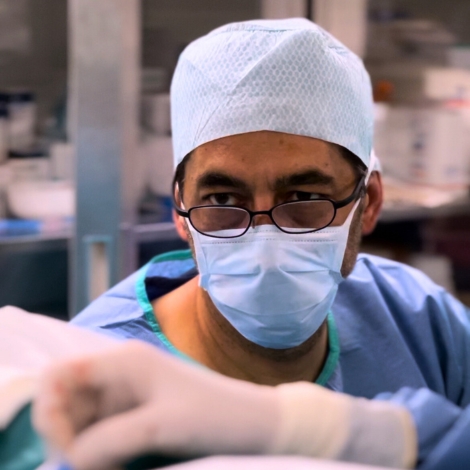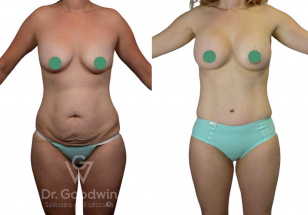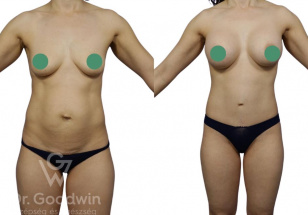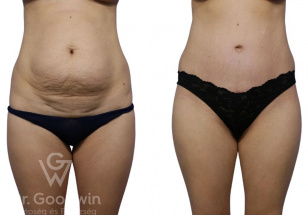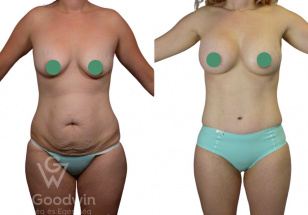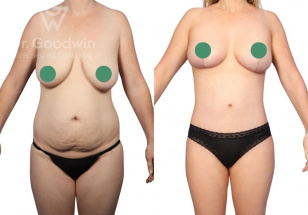Mommy Makeover
Childbirth is a beautiful experience that brings joy to many families. But it can also lead to physical changes to a woman’s body, such as sagging breasts, excess fat around the abdomen, loose abdominal skin, and stretch marks. These changes can be hard for some women to accept and may affect their self-confidence. Fortunately, there is now a surgical procedure called Mommy Makeover that can help address these issues.
About the Mommy Makeover
A mommy makeover is a combination of cosmetic surgeries that are performed to help a woman regain her pre-pregnancy body. The most common procedures included in a mommy makeover are a tummy tuck, breast lift, and liposuction. A mommy makeover can also include other procedures such as breast augmentation.
Most women who opt for a mommy makeover are in their early 30s and have had at least one child. However, there is no set age limit for getting a mommy makeover. The best candidates for the surgery are women who have finished having children and are at a stable weight. They should also have realistic expectations for the results of the surgery.
The first step in getting a mommy makeover is to consult with one of our board-certified plastic surgeon who has experience performing the procedure. During the consultation, the surgeon will examine your desired areas of improvement and create a customized treatment plan based on your goals. They will also go over the risks and benefits of the surgery with you so that you can make an informed decision about whether or not it is right for you.
If you decide to move forward with the surgery, the next step is to undergo pre-operative testing. This may include blood work, mammograms, and/or ultrasounds depending on which procedures you are having done. Once everything comes back to normal, you will be scheduled for your surgery date.
Different Mommy Makeover Methods
There are different types of mommy makeover surgery available to address the unique concerns of each patient. The most common methods include breast augmentation, breast lift, tummy tuck, and liposuction.
Breast augmentation can improve the size and shape of the breasts, while a breast lift can correct drooping or sagging breasts. A tummy tuck can tighten loose skin and muscles in the abdominal area, while liposuction can remove excess fat from areas like the thighs, hips, and buttocks.
Who Should Get a Mommy Makeover?
So, who is an ideal candidate for a mommy makeover? First and foremost, you should be done having children. Why? Because pregnancy and breastfeeding can undo all the hard work (and money) you put into your makeover. Second, you should be at or near your ideal weight. Losing weight after your surgery will decrease your chances of complications and increase the likelihood that you’ll be happy with your results.
What happens during Mommy Makeover ?
What happens during surgery may vary depending on what outcome you’d like to achieve!
The surgery contains different procedures. Based on your desires you can read detailed articles about them:
Recovery and results
Most patients report excellent results following surgery. Recovery times vary from individual to individual but typically take a few weeks. Most people take approximately three weeks before feeling well enough to return to work and their normal level of activity. It is crucial to follow all of your surgeon's post-operative instructions during recovery to ensure optimal results.
Mommy Makeover is a great way to help you get the body of your dreams, which is what you deserve after creating life and putting your body second in the past years. With proper research and preparation, individuals can safely achieve their desired look with this procedure.
Who is the intervention recommended for?
This intervention is recommended for patients who feel that their body has changed in a way that they do not want to live with due to pregnancy, childbirth, and breastfeeding, who have reached their desired weight with diet and exercise, but whose tones are no longer the same, and this needs to be changed.
Who is suitable?
A patient who has stopped breastfeeding for at least 6 months is suitable for Mommy Makeover. This is necessary so that the body can recover hormonally. In addition, the patient has reached her competitive weight and has been maintaining it for some time, which is important because physical exercise must be avoided for 2-3 months after the operation.
It is ideal if you do not smoke if you can keep away from smoking for 1-2 months before and after the operation, and if you do not suffer from any pathological diseases.
Since we are talking about combined surgery, the recovery will take longer, the part of your recovery when you cannot do even light physical work will take up to 3-4 weeks.
Postpartum plastic surgery should be performed if you think you don't want to have more children. Of course, it is possible to give birth after the intervention, but it will only hurt the results of the performed surgery, and another surgery may be necessary if we are not aesthetically satisfied with our body after giving birth.
How safe is this type of plastic surgery?
Mommy Makeover is generally safe, but each procedure has risks that increase when combined. Therefore, do not choose combinations that take more than six hours to complete. If you want more interventions, then this should be the time limit. Another important part of safety is your surgeon. Choose a plastic surgeon who has the appropriate qualifications and experience.
As with all surgeries, infection is a risk here too, pay attention to this if there is severe redness and/or the wound is pus-filled, oozing, or your pain is stronger than it should be!
The formation of blood clots is also a risk, which can develop in the first three to five days after surgery and can be quite serious. Pay attention to leg pain, swelling, or discoloration! It also indicates the formation of blood clots if you feel shortness of breath, chest pain, or cough-up blood. Abdominoplasty itself may involve more blood clots than any other cosmetic surgery procedure. If you can't decide whether what you're feeling is normal or not, definitely contact the clinic or your doctor!
In the case of combined surgeries, a higher percentage of wound healing disorders occur, which means that the wound can open along the sutures and discharge from the wound. In this case, there is no need to panic, but be sure to report this to your doctor, take a photo and send it to him, or register for a check-up.
How to prepare for the intervention?
At your first consultation, discuss all possible risks and complications with your plastic surgeon. It is important to be completely honest about your current physical and medical condition during the conversation, as this is the only way to avoid complications.
Doctors must inform you about the medical equipment needed for recovery so that you can buy it in advance. These include compression garments, stool softeners /pain relievers that can cause constipation/ and supplements recommended by a doctor.
It is a good idea to ask for help with the care of children and pets in the first week after surgery and to cook some food in advance and keep it in the freezer so that you can rest and heal.
At least four weeks before surgery (or sooner if possible), stop smoking or use nicotine replacement therapy, which can increase the risk of serious complications and slow healing, as nicotine can reduce the blood supply to the raised and tighter skin.
Your doctor must know about any medication or dietary supplement you are taking! Certain preparations are prohibited to be used in the period before surgery, while others may be used. People with chronic pain receiving opioid therapy should talk to their surgeon, family doctor, and anesthesiologist about making adjustments during surgery and recovery. For example, if you take Tramadol daily, it may be necessary to change this, which does not mean that the operation cannot be performed, but the pain that occurs after the operation is more difficult to relieve. If you regularly use opioid pain relievers, they can suppress the treatment used to reduce surgical pain, so more drugs or other pain relievers may be needed. If you're taking antibiotics, that shouldn't be a problem, but be sure to let your surgeon know if you have any active infection, because the disease for which you used the medicine may already be a cause for concern. It is possible that the operation has to be postponed due to an active infection, as it involves additional stress, which can interfere with the body's immune response to the infection, and the active infection can spread to, for example, the new breast implant.
Also, inform your doctor if you are taking dietary supplements for weight loss! Do not take phentermine before or on the day of surgery because it can cause complications from anesthesia.
Ask your surgeon if you can leave the nail polish or artificial nails on because they can interfere with the oximeter. In most cases, doctors ask that you have at least one nail without any polish. This is necessary so that the blood oxygen level can be checked during the operation.
What happens during the intervention?
The procedure can be performed in a hospital or in an independent institution that meets all the conditions and regulations which is a condition of the official permit. If your procedure is not performed in a clinic suitable for inpatient care, make sure that your plastic surgeon has the appropriate qualifications and hospital privileges, that is, whether and what kind of institutional background he/she has. The latter is important so that in the rare case of a serious complication, you can receive emergency care quickly.
After you are prepared for the operation, you will be given a consent form, then you will be wheeled into the operating room and sedated until the procedures are finished.
- During breast augmentation with a breast lift, the surgeon lifts and transforms the breast tissue, removes excess skin, and often repositions the nipple so that it is higher on the breast. Click here for a description of the breast augmentation procedure with implants!
- Breast augmentation is usually done by inserting silicone implants above the pectoral muscle. If you only want a small breast augmentation, the surgeon can perform the fat transfer. Then, by liposuction and injection, the fat is transferred from other areas of the body /abdomen, thighs/ to your breasts. Click for a description of the breast augmentation procedure!
- To perform a tummy tuck, the surgeon makes an incision from hip to hip, pulls back the skin and underlying abdominal tissue, repairs and tightens the abdominal muscles, and removes excess skin and tissue. If necessary, he fixes the hernia or diastasis recti and then closes the incision. Click for a description of the abdominoplasty procedure!
- During liposuction, the surgeon inserts a thin, hollow tube /cannula/ through small incisions to suck out excess fat. Some types of liposuction tighten the skin which solves the problem of sagging and sagging skin. Click for a description of the liposuction procedure!
- A surgeon specializing in vaginal rejuvenation tightens the opening of the vagina with perineoplasty and restores the vaginal canal and its surface with vaginoplasty. Prolapse, which is a condition where organs are pushed into the vaginal canal, can also be repaired surgically. You may also want to consider non-surgical laser and radiofrequency energy treatments such as ThermiVa, MonaLisa Touch, or diVa vaginal therapy to tighten tissues and reduce urinary retention problems. Click for a description of the vaginal rejuvenation procedure!
- A Brazilian butt lift /BBL/ injects fat removed by liposuction into the buttocks to increase the amount of fat and create new contours. You should take into account that this is one of the riskiest types of plastic surgery, so it is essential that you find the right specialist who adheres to the latest safety guidelines! Click for a description of the Brazilian buttock augmentation procedure!
After the operation, you will be taken to a restroom, where your condition will be monitored until you wake up. Both breast augmentation and tummy tucks will have long incisions unless the surgeon uses a new procedure developed for women with less loose tissue, a technique called a hybrid tummy tuck, which involves a smaller, C-shaped incision.
Two small drainage tubes are usually placed through the incisions to prevent fluid from accumulating, but this is not used by everyone.
You may be able to go home a few hours after your surgery, but don't be surprised if your doctor asks you to stay overnight for further observation. Mommy Makeover is a major intervention that requires several hours of surgery, so you will definitely have to spend a night in the clinic, so you can only go home the next day, but even then only if your condition is stable. The required surgical time depends on the structure of the body /thin or fuller figure/ and the skill and practice of the surgeon. The combined surgical procedure takes an average of 3-5 hours, which can take up to six hours if the combination of procedures is very lengthy. That is why, for your safety, there is an upper limit on the number of procedures that can be performed at the same time, and take into account that abdominoplasty can take up to three to four hours.
Abdominoplasty after childbirth: how painful is it?
Since the procedure is performed under anesthesia, you will not feel any pain during it. Immediately after the operation, you will be given painkillers, and they will also prescribe them at home, which you will probably have to take for four to seven days, after the first week the pain should subside. Talk to your doctor about what over-the-counter medications you can take. Avoid blood thinners (such as ibuprofen), which can affect normal blood clotting.
If you have serious pain during recovery, don't hesitate and contact your doctor! Pain can take away the energy needed for healing and it is good to get to the bottom of what causes the complaints.
What can you expect during the recovery period?
Recovery time for a Mommy Makeover depends on exactly which procedures were performed, but you can expect to need at least two weeks off, and a maximum of six to eight weeks if your work is physically demanding. You can return to your daily activities during the two-week recovery period, but you must not exercise or lift anything for three weeks, and you must give up sports for six weeks!
Swelling and bruising will begin to decrease after one to three weeks, and you will see the final results at the end of the healing period, within six months. Scars take six to twelve months to heal, so it is completely normal for your scars to be reddish-pink and swollen in the period following surgery.
Coughing and more throat secretions may occur, these are not at all rare companions of the post-surgery period. During breast surgery and abdominoplasty performed under long-term anesthesia, you are ventilated with a breathing tube, which can cause respiratory secretions. In addition, all this is supplemented by the fact that due to strained abdominal muscles and expanded lungs, you will not be able to clear your throat immediately, and coughing can also be painful. However, when you cough, it helps to clear the phlegm. To prevent pain, keep a pillow on your stomach, and a short walk will also help you to return to normal breathing and activity.
What results can be expected and how long will the desired effect last?
The results should last for at least a decade if you pay attention to living a healthy life and maintaining your weight. Remember that breast implants cannot be considered permanent, so they may need to be replaced over time, which is why it is important to go for the necessary medical check-ups. Follow the instructions both during the healing period and afterward. The Mommy Makeover surgery does not stop time either, so the signs of natural aging after the surgery will be visible on your chest, stomach, and face.
What alternatives are there?
No amount of exercise can tighten loose, flabby, stretch-marked skin, or repair tore or split abdominal muscles. Sagging, hanging breasts cannot be rejuvenated without plastic surgery.
It follows that there is no other option that can produce the spectacular effect of Mommy Makeover. Only a few non-surgical treatments can help the condition, which is non-invasive, and based on experience so far, they help but do not add to the results of the surgery.
A non-surgical body contouring procedure for example is fat freezing, which reduces the amount of fat, but does not get rid of excess skin. Some doctors recommend this treatment in the months before the Mommy Makeover to avoid liposuction, as it increases the risk of complications.
Non-surgical laser and radiofrequency devices such as ThermiVa, MonaLisa Touch, diVa vaginal therapy, and Votiva can tighten vaginal tissues and reduce urinary retention problems.
What interventions does the Mommy Makeover include?
One of the biggest advantages of postpartum plastic surgery is that it combines several procedures in a single surgical session. It is customized to meet the unique needs of each patient, but generally includes the following surgical procedures:
- Abdominoplasty, in some cases combined with a diastasis recti repair, to tighten the abdomen and repair detached muscles.
- Breast augmentation with or without breast suturing, to lift the drooping breast or compensate for the lost size, or breast reduction is necessary if the pregnancy was accompanied by extreme breast growth.
- Liposuction is the removal of excess fat to restore body shape.
- Some women also choose perineoplasty /vaginal rejuvenation/ to tighten their vaginal opening and vaginoplasty to improve the surface of their vagina.
- Although this is less common, some people also request Brazilian buttock fillers.
When can silicone scar treatment be used after postpartum plastic surgery?
Medical silicone scar therapy in the form of bandage-like sheets or gel, prevents pathological scars, hypertrophic scars and keloids. It is applied to the incision site when there are no more pieces of the wound and there is no exudation anywhere. They keep the scars hydrated and help prevent permanent scarring. You can start using silicone scar treatment approximately one month after surgery, but be sure to consult your doctor before doing so. Using it too soon can cause moisture to build up, which can lead to infection.
Will there be permanent scars after a Mommy Makeover?
Because of the incisions, yes, you will have scars, but these can usually be well hidden under clothing /even in a bathing suit/ and will fade over time. Don't forget that everyone heals differently and everyone wants optimal scars that heal well, but it takes time and unfortunately not everyone heals that way. Post-inflammatory hyperpigmentation /PIH/ may cause brown or purple spots. PIH is a common response of the skin to local inflammation, trauma, or surgery, and is caused by the body's increased production of melanin during healing. There are many methods of scar treatment. Those who use hydroquinone are against pigmentation problems, and microfracture with PRP or laser therapy can also be effective.
What are some common misconceptions about the Mommy Makeover?
The intervention is a weight loss intervention and causes significant weight loss.
Unfortunately, this is not the case. The patient will lose less by the excised skin area, which also removes the subcutaneous fat layer, but this is usually no more than one or two kg.
Any intervention can be performed within the framework of Mommy Makeover.
Unfortunately, this is also a misconception. The number of interventions is limited by the surgical time spent on them. In Hungary, patients are not put to sleep for more than 5-6 hours, so the operating time determines how many interventions can be performed on a given patient.
Any surgery can be performed at the same time.
This is also a misconception. There are cases when two types of surgery are mutually exclusive. Examples include breast augmentation and otoplasty, as the patient cannot lie on either side. Although these two types of surgery are not average within the framework of Mommy Makeover, they clearly illustrate the situation in which it is not possible to operate on two areas at the same time.

